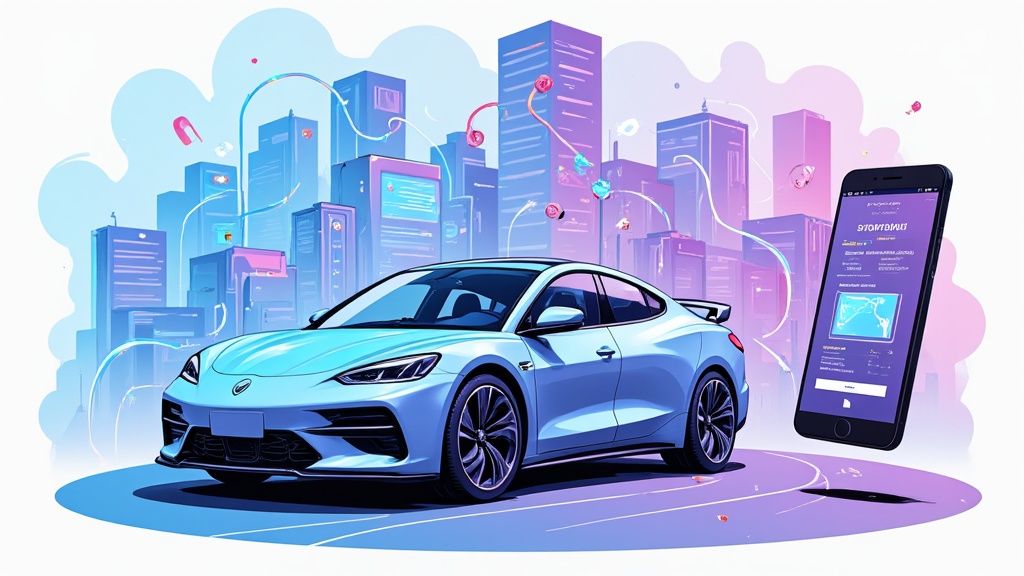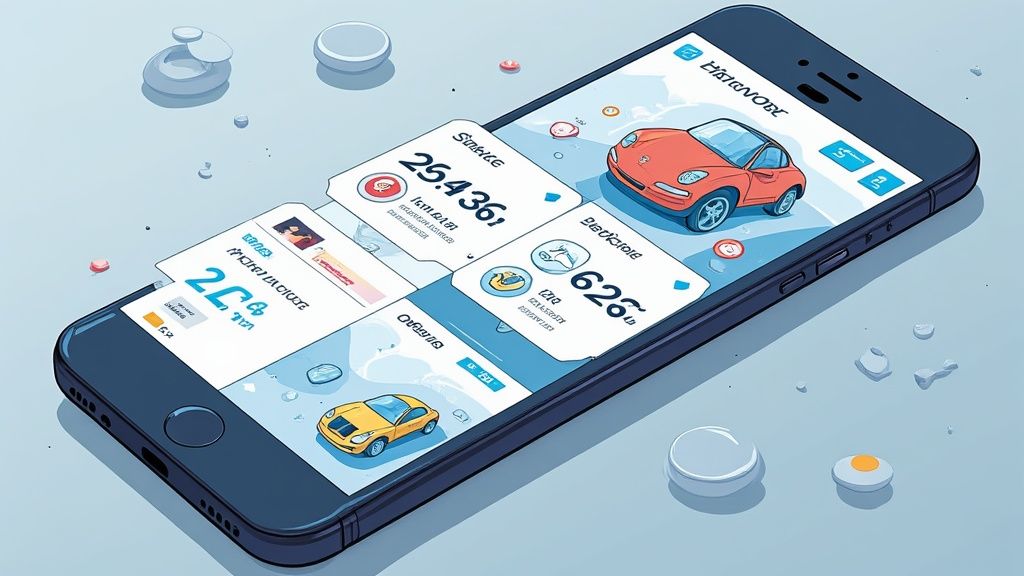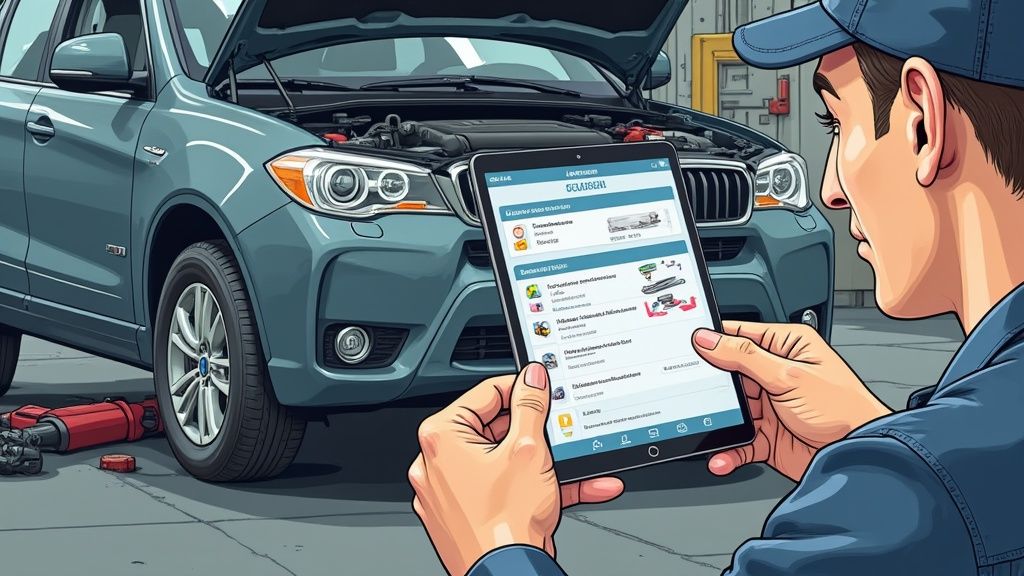
Vehicle Service Apps: Your Complete Guide to Smarter Car Maintenance
Understanding the Vehicle Service App Revolution

Car maintenance has come a long way from paper records and warning lights. Mobile apps have fundamentally changed how we care for our vehicles by becoming essential digital tools for modern car owners. The rapid growth of connected car technology and smart devices has driven this shift - for instance, the global in-vehicle apps market reached $59.5 billion in 2023 and is set to grow over 9% annually through 2032, showing just how important these tools have become.
From Reminders to Real-Time Diagnostics
The earliest vehicle service apps simply sent maintenance reminders, but today’s versions do much more. Modern apps use artificial intelligence and live diagnostic data to make car care more proactive and easy to manage. Rather than just remind you about oil changes on a fixed schedule, these apps can analyze your actual driving patterns and vehicle data to determine when service is truly needed. They can also spot potential problems early, helping prevent costly repairs down the road.
The Benefits of Embracing Vehicle Service Apps
People who have adopted these apps are discovering clear advantages beyond basic convenience. The apps give car owners better oversight and control of their vehicle’s maintenance needs. Features like online booking, parts tracking, and performance monitoring help save both time and money. Users can easily compare service prices, schedule appointments when it works for them, and track parts deliveries - all without making multiple calls or visits to repair shops.
The Future of Connected Cars and Vehicle Service Apps
Major car companies are investing heavily in creating better, more capable service apps to improve the ownership experience. This includes adding advanced data tracking that provides useful insights from real-time vehicle information. Many apps now let owners monitor fuel efficiency, analyze driving habits, and receive alerts about mechanical issues. With passenger vehicles making up 75% of the in-vehicle app market, there’s strong demand driving continued improvements. As technology advances, these apps will become even more seamless and proactive in helping manage vehicle maintenance, making them essential tools for every car owner.
Essential Features That Actually Matter
Vehicle service apps have become crucial tools for today’s car owners. Before diving into any new app, it’s important to know which features really improve your maintenance experience versus those that just sound impressive in marketing materials. Let’s explore the key capabilities that make an app truly helpful.

Real-Time Diagnostics and Predictive Maintenance
Modern vehicle service apps now offer powerful real-time diagnostic capabilities that go far beyond basic dashboard warning lights. These systems can detect subtle changes in engine performance before they develop into serious problems. For instance, if your engine’s timing is slightly off but not enough to trigger a warning light, the app can alert you early, helping prevent costlier repairs down the road. The apps also create personalized maintenance schedules based on your actual driving patterns and vehicle data, rather than following a one-size-fits-all approach. This means you get service when your car truly needs it, helping extend its life while avoiding unnecessary maintenance costs.
Streamlined Service Booking and Parts Management
A good vehicle service app simplifies the entire maintenance process from start to finish. You can book service appointments directly through the app without playing phone tag with repair shops. Some apps even track parts inventory, showing you exactly when needed components will be available. For example, if your vintage car needs a specific part, the app can locate it and provide delivery estimates, taking the guesswork out of repairs. This clear communication helps you plan ahead and minimizes the time your car spends in the shop.
Performance Monitoring and Data-Driven Insights
Advanced apps provide detailed performance tracking for key metrics like fuel efficiency, driving patterns, and tire pressure. This information helps you understand your vehicle’s health and identify ways to improve its performance. The app might show that frequent hard braking is wearing down your brake pads faster than normal, allowing you to adjust your driving style and save money on replacements. By making data easy to understand and act on, these apps help you make smart decisions about your car’s maintenance.
Integration and User Experience
The best features mean little if an app is difficult to use. Good vehicle service apps work smoothly with different car makes and models while connecting easily to onboard computer systems. The interface should feel natural and intuitive, like reaching into a well-organized toolbox where everything has its place. You should be able to quickly find what you need, whether it’s scheduling an oil change or checking your fuel efficiency history. This thoughtful design makes maintaining your vehicle feel less like a chore and more like a natural part of car ownership. When choosing an app, look for one that combines powerful features with straightforward, accessible controls.
Solving Real-World Connectivity Challenges

The effectiveness of any vehicle service app relies heavily on consistent connectivity. When connection problems arise, even the most feature-rich app becomes frustrating rather than helpful. Let’s explore the common connectivity challenges users face and practical ways to overcome them.
Understanding Common Connectivity Roadblocks
Connection disruptions between your vehicle, smartphone, and service app can stem from multiple sources. Basic issues like poor cellular reception or Bluetooth interference are common culprits. More complex problems often involve the vehicle’s onboard diagnostics system (OBD) - for instance, when outdated OBD firmware fails to work with recent app versions. Software bugs and server problems can also temporarily interrupt service. This mix of potential issues means fixing connectivity problems requires checking multiple components.
Maintaining a Reliable Connection
Experienced app users follow several key practices to keep their connections stable. They start by ensuring strong Bluetooth and cellular signals, since weak connections can block real-time data transmission just like poor Wi-Fi affects streaming. Regular app updates are also essential since they often fix known bugs and improve performance. Users also make sure their vehicle’s OBD system works well with their chosen app, as compatibility varies between different combinations of apps and OBD systems.
Troubleshooting Connectivity Issues
When problems occur despite preventive steps, systematic troubleshooting helps identify the cause. Begin with basic checks - is Bluetooth turned on? Do you have good cell service? Often, simply restarting your phone and vehicle clears up minor glitches. For persistent issues, consult the app’s help documentation or look for solutions in online forums where other users discuss similar problems with your specific vehicle model. The app’s customer support team can help tackle more challenging technical issues. Recent data from the J.D. Power 2023 U.S. OEM ICE App Report shows connectivity challenges affect nearly one-third of vehicle owners, with slow connections being the most common complaint at 64%.
Backup Strategies: Staying Connected When Systems Fail
Having fallback options prevents you from getting stranded during connectivity failures. Download important documents like maintenance records and manuals for offline access - similar to keeping paper maps as GPS backup. Learn to read your vehicle’s warning lights and understand what they mean, so you can spot problems even without the app’s diagnostics. This allows you to make smart decisions about seeking help when needed, even if real-time app data isn’t available. While vehicle service apps provide valuable tools, maintaining basic car knowledge remains important. This balanced approach helps you get the most from your app while being prepared for connectivity issues.
Maximizing Telematics for Better Performance

Modern vehicles generate tremendous amounts of data that can be used to improve performance and maintenance. Through telematics systems in vehicle service apps, this raw data is converted into clear insights that help car owners make smarter decisions about vehicle care. By moving from reactive to proactive maintenance, telematics is changing how we maintain our vehicles.
Understanding the Power of Data Insights
Think of your vehicle service app as a watchful mechanic that continuously monitors your car’s health. Using sensors connected to the onboard diagnostics system (OBD), telematics collects detailed data about engine performance, fuel use, driving patterns, and tire pressure. This means you no longer have to rely on standard maintenance schedules - instead, service recommendations are based on your actual driving behavior and vehicle condition. For instance, if you frequently make short trips in cold weather, the app may suggest more frequent oil changes.
Predictive Maintenance: Preventing Problems Before They Start
One of the biggest advantages of telematics is its ability to catch problems early. By tracking data patterns over time, vehicle service apps can spot developing issues before they lead to breakdowns. As an example, if the app notices a steady drop in fuel efficiency, it may indicate that your fuel injectors need cleaning. Getting ahead of such problems helps you avoid costly repairs and keeps your vehicle running smoothly - much like how regular health screenings help prevent medical issues.
Optimizing Maintenance Schedules for Peak Performance
Vehicle service apps use telematics data to create maintenance schedules matched to how you actually use your car. Rather than following fixed intervals, service timing is adjusted based on your specific driving patterns and component wear. For example, someone who mainly drives on highways may need less frequent brake service than a city driver who deals with stop-and-go traffic. This personalized approach ensures your car gets the right care at the right time to maintain optimal performance.
Real-World Applications of Telematics
The benefits of telematics extend well beyond individual vehicle owners. Fleet managers use these systems to monitor entire groups of vehicles, optimizing routes and maintenance while reducing operating costs. The technology also helps identify unsafe driving habits through features that track behavior, allowing for targeted driver training. With the in-vehicle apps market growing by over 9% each year, telematics will play an even bigger role in vehicle care going forward. By embracing these capabilities now, you can take a more proactive approach to maintenance that saves time and money while preventing unwanted surprises.
Making Smart Choices in App Selection
Finding the right vehicle service app takes careful consideration, especially given how many options are available today. Making an informed choice can make a big difference in how effectively you maintain your vehicle. Let’s explore what separates truly helpful apps from basic ones.
Key Factors to Consider When Choosing a Vehicle Service App
When evaluating vehicle service apps, start by checking compatibility with your specific vehicle. The app needs to work properly with your car’s make, model, and onboard diagnostic system (OBD). For instance, an app built for electric vehicles may not function correctly with a gas-powered car. Next, look at the app’s features - does it provide real-time diagnostics, maintenance reminders, service scheduling, and parts tracking? Focus on capabilities that match your maintenance needs.
The app’s user experience is equally important. You want an interface that’s clear and easy to navigate, like having a well-organized toolbox where you can quickly find what you need. Pay attention to reliability and connectivity as well. According to J.D. Power’s 2023 U.S. OEM ICE App Report, nearly one-third of vehicle owners face connectivity issues, with slow connections being the most common problem. Look for apps that consistently perform well based on user reviews.
Evaluating App Features and Benefits
A quality vehicle service app serves as your maintenance assistant, helping you stay on top of your car’s needs. Real-time diagnostics alert you to potential issues before they become serious problems. Predictive maintenance uses your actual driving data to create optimal service schedules, helping you save time and money. Service booking features eliminate phone tag with repair shops, while parts tracking keeps you informed about component availability and delivery status.
User Insights and Expert Recommendations
Take time to read reviews from other car owners who’ve used the apps you’re considering. Their real-world experiences can help you understand which apps deliver consistent value. Automotive professionals and tech reviewers also offer valuable perspectives on factors like ease of use, customer support quality, and overall effectiveness in simplifying vehicle maintenance.
Making the Switch: Considerations for Changing Apps
If you decide to switch apps, keep a few key points in mind. Check whether you can transfer your vehicle data from your current app to the new one. Verify that the new app works with your OBD system and any connected devices you use. Most quality apps offer free trials - take advantage of these to thoroughly test the app before committing. By carefully weighing these factors, you can select an app that helps you maintain your vehicle effectively and improves your ownership experience.
Future Innovations Worth Watching
Smart vehicle apps continue to advance thanks to new technology and changing owner needs. Understanding what’s on the horizon helps you make informed choices about car maintenance apps today and prepares you for changes ahead.
Augmented Reality for DIY Repairs
Next-generation vehicle apps will include augmented reality (AR) features to help owners complete basic repairs. By overlaying repair instructions through your phone’s camera view of the engine bay, AR apps can provide step-by-step visual guidance. For instance, an AR overlay could point out exactly where to find and how to remove an oil filter, making DIY maintenance much more approachable. This helps car owners tackle simple fixes themselves to reduce service costs.
Advanced Diagnostics Powered by Machine Learning
While today’s apps can run real-time diagnostics, future versions will use machine learning to spot problems earlier. By analyzing data from many vehicles, these apps will identify subtle warning signs that current systems miss. For instance, the app could alert you about a part that’s starting to wear weeks before it fails completely. This gives you time to schedule preventive maintenance and avoid roadside breakdowns.
Enhanced Connectivity and Reliability
Strong connectivity is essential for vehicle service apps to work well. The rollout of 5G networks will enable faster data transfer with minimal delay, leading to more accurate diagnostics and maintenance predictions. New satellite communication systems will also help maintain consistent app connections in rural areas with poor cell coverage, making these apps useful everywhere.
Preparing for the Future of Vehicle Maintenance
These advances will make vehicle service apps much better at helping owners care for their cars. Staying informed about new features helps you pick an app that grows along with technology. Making good use of advanced vehicle apps keeps your car maintenance organized and efficient as capabilities expand.
Ready to start tracking your car maintenance the smart way? Auto Service Logger provides a central hub for all your service records and vehicle history. Visit Auto Service Logger to learn more and begin simplifying how you manage car care.